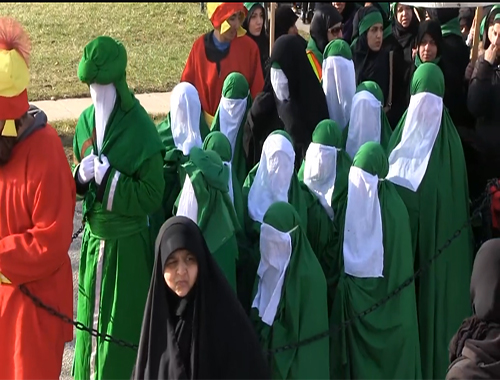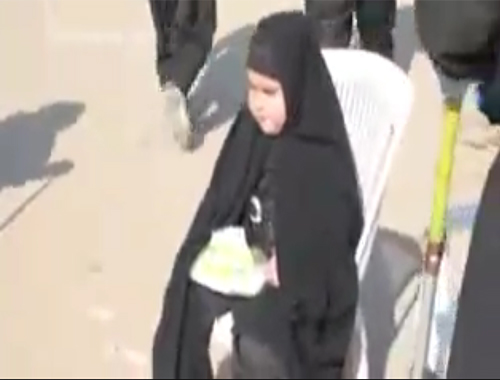The Abbasid Caliphs During the Lifetime of Imam Reza(AS)
- Details
- Hits: 12100
.jpg)
The Abbasid Caliphs During the Lifetime of Imam Reza(AS)
1. Abu Jafar al-Mansur: Abbasid caliph; born 709, r. 136-158 A.H/
754-775 A.D.
2. Muhammad bin Abdullah al-Mahdi r. 158-169 A.H., / 775-785
A.D.,
3. Musa al-Hadi, r. 169-170 A.H.,/ 785-786 A.D.
4. Harun al-Rashid r. 170-193 A.H.,/ 786-809 A.D.
5. Abu Abdullah Muhammad al-Amin r. 193-198 A.H.,/ 809-813 A.D.
6. Abdullah Abul Abbas al-Mamun r. 198-218 A.H.,/ 813-833 A.D.
754-775 A.D.
2. Muhammad bin Abdullah al-Mahdi r. 158-169 A.H., / 775-785
A.D.,
3. Musa al-Hadi, r. 169-170 A.H.,/ 785-786 A.D.
4. Harun al-Rashid r. 170-193 A.H.,/ 786-809 A.D.
5. Abu Abdullah Muhammad al-Amin r. 193-198 A.H.,/ 809-813 A.D.
6. Abdullah Abul Abbas al-Mamun r. 198-218 A.H.,/ 813-833 A.D.
1. Abu Jafar al-Mansur (136-158 A.H/ 754-775 A.D.)
Abu Jafar Abdullah bin Muhammad bin Ali Abbasi was born in the year 101 A.H./ 709 A.D. in the Hamimah village. His mother was a Berber slave named Salamah. He spent his childhood among the Bani-Hashim. During Saffah's caliphate he attained distinguished political positions. In the year 132 A.H., Saffah appointed him as the governor of Jazira, Azerbaijan and Armenia.
In the year 136 A.H., he was designated as the Amir al-Hajj and as his successor by Saffah. Al-Mansur became the Caliph soon after the death of his brother Saffah in 136 A.H. First he crushed the rebellion led by his uncle Abdullah bin Ali and assassinated Abu Muslim Khurasani.
He deposed Isa bin Musa bin Muhammad bin Ali as his successor and in his place appointed al-Mahdi as his successor and took public allegiance for him.
He was a miserly person and there are many events related to his evil attribute and for his evil-habit he became famous as Dawaniqi and thus was called al-Mansur Dawaniqi. Like his elder brother Saffah he was a blood-thirsty person and annihilated all his opposition.
Al-Mansur crushed the uprising of Sanbad in the year 138 A.H., revolt of Astazsis in the year 151 A.H. and movement of al-Muqannah in the year 163 A.H. Al-Mansur many times imprisoned Imam Jafar al-Sadiq (AS) and martryed the Sixth Holy Imam (AS) by poisoning in the year 148 A.H.
He killed a large number of Shi'ites (the followers of the Holy Ahlul Bayt (AS). Al-Mansur created a museum out of the severed heads of the Shi'ites in which the identity of those killed was mentioned and displayed below the severed heads. (Tarikh al-Tabari vol 10, p. 446).
Al-Mansur was the first person to destroy the holy shrine of Imam Husain (AS) at Karbala (Iraq). Al-Mansur placed the bodies of the Sayyids and Shi'ites in the construction of the columns of his palaces in the city of Baghdad.
He was also notorious in breaking the pledges and promises for refuge granted by him to his opponents. Al-Mansur was a gluttonous person and died due to excessive eating in the year 158 A.H./ 775 A.D. (The Political Histroy of Islam, vol. 2, p. 57).
2)Al-Mahdi, Abu Abdullah Muhammad (158-169 A.H./ 775-785 A.D.).
He was born in the year 126 A.H./ 746 A.D. in the Hamimah village. His mother'a name was Arwi and his father was Mansur Dawaniqi, the Abbasid caliph. Al-Mahdi was ten years old when his father became the caliph. When he was only fifteen years old was sent to Khurasan to crush the rebellion of Abdur Rahman bin Abdul Jabbar Azdi. He also subdued the uprising of Ispahbud, governor of Tabaristan and crushed the rebellion of Astazsis in the year 151 A.H. and massacred more than 70000 followers of Astazsis in Khurasan. In the year 153 A.H., al-Mahdi was appointed as Amir-al-Hajj and after the death of his father al-Mansur became the caliph.
Al-Mahdi reigned for ten years. He imprisoned his most trusted vizier Yaqub bin Dawood and captivated him in a dungeon until he died. In the year 167 A.H./ 783 A.D., al-Mahdi instituted an official inquisition to execute the alleged Zindik (heretics) Many of his opponents were executed by him with the false allegations of being Zindik. in the official inquisition. He was fond of music and erotic poetry and during his caliphate the musicians and erotic poets were patronized and he universilized music and erotic poetry in his dominion.
In the year 161 A.H., he subdued the rebellion of Abdullah bin Marwan bin Muhammad the Umayyad remnant in Syria. In 160 A.H. he put down the insurrection of Yusuf bin Ibrahim in Khurasan. In the same year al-Mahdi deposed Isa bin Musa as his successor and appointed Musa Hadi in his place and took allegiance for him from the nobles. Al-Mahdi was poisoned by one of his concubines in the year 169 A.H./ 785 A.D.).
3)Al-Hadi Abbasi (169-170 A.H./785-786 A.D.)
Al-Hadi is the regnal name of the Abbasid caliph Musa bin al-Mahdi. He became the caliph after the death of his father. He was a cruel and blood-thirsty despot and massacred the Sayyids and Shi'ites during his reign. It became the regular practice and tradition of the Abbasid caliphs to massacre the Shi'ites. Husain bin Ali bin Hasan bin Ali bin Abu Taleb rose against him in the holy city of Madina in the year 169 A.H./ 786 A.D. and was brutally martyred along with all his companions near Mecca in a locality called as Fakhh by the Abbasid forces.
Al-Hadi was a drunkard and licentious person and like his father al-Mahdi patronized musicians, singers and erotic poets. He used to shower costly presents and gifts to the musicians, singers and court poets. They even claimed that if al-Hadi lived more we even could had built our houses with golden bricks.
In the year 170 A.H./ 786 A.D., al-Hadi tried unsuccessfully to depose Harun al-Rashid as his successor and instead appoint his young child Jafar as his successor. In the same year al-Hadi was poisoned by his mother Khizaran in a plot hatched by his brother Harun al-Rashid and his vizier Yahya bin Khalid Barmaki. The night al-Hadi was killed, Harun al-Rashid became the caliph and on the same night al-Mamun was born who later became the caliph and al-Mamun martyred Imam Reza (AS) in the year 203 A.H./ 818 A.D.
4)Harun al-Rashid (170-193 A.H./ 786-809 A.D.)
Due to the "Thousand -and-One Nights" tales Harun al-Rashid turned into a legendary figure obscuring his true historic personality. In fact, his reign initiated the political disintegration of the Abbasid caliphate. Syria was inhibited by tribes with Umayyad sympathies and remained the bitter enemy of the Abbasids and Egypt witnessed uprisings against Abbasids due to mal-administration and arbitrary taxation.
The Umayyads had been established in Spain in 755 A.D., the Idrisids in the Maghrib(Morocco) in 788 A.D., and the Aghlabids in Ifriqiya(Tunis) in 800 A.D. Besides, unrest flared up in Yemen, and the Kharijites rose in rebellion in Daylam, Kirman, Fars and Sistan. Revolts also broke out in Khurasan. He waged many campaigns against the Byzantines.
For the administration of the whole empire he fell back on his mentor and long time associate Yahya bin Khalid bin Barmak. Rashid appointed him as his vazier with full executive powers, and, for seventeen years, this man Yahya and his sons, served Rashid faithfully in whatever assignment he entrusted to them. But Harun al-Rashid in 187 A.H. brutally eliminated all the members of Barmakid family.
Al-Rashid appointed Ali bin Isa bin Mahan as the governor of Khurasan. He tried to bring to heel the princes and chieftains of the region, and to reimpose the full authority of the central government on them. This new policy met with fierce resistance and provoked numerous uprisings in the region. A major revolt led by Rafeh bin Layth was started in Samaqand which forced Harun al-Rashid to move to Khurasan.
He first removed and arrested Ali bin Isa bin Mahan but the revolt continued unchecked. Harun al-Rashid died very soon when he reached Sanabad village in Toos and was buried in the summer palace of Humaid bin Qahtabah, the former Abbasid governor in Khurasan, situated near the Sanabad village in the Toos region.
Harun al-Rashid was bitterly opposed to the Sayyids and the Shi'ites and carried the annihilation of them during his reign. Harun was the second Abbasid Caliph to destroy the tomb on the holy grave of Imam Husain (AS) in Karbala. The most serious and heinous crime of Harun was the martrydom of Seventh Shi'ite Imam Musa bin Jafar (AS) after torturing the Holy Imam (AS) in various prisons for a lengthy period of 14 years.
He imposed heavy taxes on farmers, traders and artisans. He maintained 4000 slave-girls and concubines to entertain him.
Al-Rashid virtually dismembered the empire by apportioning it between his two sons al-Amin and al-Ma'mun. Very soon it became clear that by dividing the empire, Rashid had actually helped to set the opposing parties against one another, and had provided them with sufficient resources to become independent of each other. After the death of Harun al-Rashid civil war broke out in the empire between his two sons al-Amin and al-Ma'mun.
5. Abu Abdullah Muhammad al-Amin r. 193-198 A.H.,/ 809-813 A.D.
Abbasid caliph, b. 787 A.D., ruled from 809-813 A.D./ 193-198 A.H., His mother was Zubaydah daughter of Jafar bin Mansur. His father Harun al-Rashid, in the so-called "Meccan Documents", designated al-Amin as the caliph after him and his other Abdullah al-Mamun as al-Amin's successor.
His short span of reign was very tumultuous and disorderly. Ali bin Abdullah famous as Sufyani rose in revolt in Syria and he was successful in capturing Damascus. Al-Amin was very arrogant, cruel and pleasure-seeking person and gathered musicians, poets and dancers in his palace in Bagdad and spent all his time with them and disbursed great amount of gold and silver amoung them. He gave all his powers and administrative control to Fazl bin Rabi, one of the close associates of Harun al-Rashid.
Al-Amin created special places for entertainment in the palaces in Baghdad and constructed very costly yacht to ride in the Tigris river.
Al-Amin in 193 A.H./ 809 A.D., dismissed his younger brother Qasim Mutamen from the governorship of Jazirah and appointed Khuzaimah bin Khazam in his place. In 194 A.H./810 A.D., al-Amin deposed al-Mamun as his successor and declared his son Musa as his successor thus clearly violating the contents of the so-called "Meccan Documents".
Open hostility broke out between him al-Mamun who was based in Marw(Khurasan,Iran) as the governor of eastern provinces of caliphate like Khurasan, Sistan and Transxiana.
Al.Amin send a powerful army of 70000 men under the command of Ali bin Isa bin Mahan. who met the forces of al-Mamun, under the command of Tahir bin Husain at the battlefield near Rayy. The result was a resounding defeat for Al-Amin's forces and Ali bin Isa bin Mahan was killed and his army retreated in complete disarray to Baghdad.
Tahir bin Husain laid the siege of Baghdad for fourteen months and finally captured Baghdad which was largely destroyed. Thus the fanciful city of Baghdad famous in the Thousand and One Nights tales was destroyed by al-Mamun's army and the beautiful palaces built by the earlier Abbasid caliphs were laid to ruins. Al-Amin was killed in Baghdad by Tahir bin Husayin and Abdullah al-Mamun became the caliph with his capital based in Marw, Khurasan.
6. Abdullah Abul Abbas al-Mamun r. 198-218 A.H.,/ 813-833 A.D.
Abul Abbas Abdullah al-Mamun Abbasid caliph was born in 15th of Rabi-al-Awwal 170 A.H. at a village called Yasiriyyah near Baghdad His mother was named Marayel, a Iranian slave-girl from Badkhis in Khurasan province. When he was twenty-three years old he was appointed as his second successor according to the so-called "Meccan Documents" and designated as the governor of the eastern provinces of the kingdom like Sistan, Khurasan, Kirman and Transxiana.
When his father Harum al-Rashid died in the year 809 A.D./193 A.H., al-Mamun was the governor of the eastern provinces of the caliphate. In 194 A.H./810 A.D., al-Amin deposed al-Mamun as his successor and declared his son Musa as his successor and annuled "the Meccan Documents."Thus open hostility broke out between him and al-Amin His army under the command of Tahir bin Husain defeated the powerful army of al-Amin at Rayy.
In 816 A.D./198 A.H. al-Amin was killed by Tahir bin Husain after siege of Baghdad for fourteen months and al-Mamun became the caliph with his capital based in Marw, Khurasan. He reigned as caliph for a period of twenty years.
In order to suppress the power of Sayyids and Shi'ites who had risen in revolt in Iraq and Iran, al-Mamun in the year 200 A.H., forced Imam Reza (AS) to leave Madina and he send a special contingent under the command Raja bin Dhahhak to bring the Holy Imam (AS) to Marw. In 201 A.H./817 A.D., al-Mamun declared Imam Reza (AS) as his successor designate but the Holy Imam(AS) refused to get involved in the administrative affairs of the state.
In 203 A.D./ 818 A.D., al-Mamun martyred Imam Reza (AS) by poisoning and the Holy Imam (AS) was buried in Sanabad, Toos which is now called as the holy city of Mashhad. After the martyrdom of Imam Reza (AS) Khurasan was struck with a massive earth quake which destroyed many cities and villages in this region and earth quake shocks were reported for continuous period of more than seventy days in which most of the Khurasan was devastated.
In 204 A.H/ 819 A.D. al-Mamun went to Baghdad and set aside all the symbols of Shi'ite Islam which he adopted only to appease the Sayyids and Shi'ites and strengthened his rule by winning the favour of the Abbasids.
In 824 A.D.al-Mamun proclaimed Mutazilism as the official doctrine of the caliphate and imposed his doctrine that the Holy Qur'an was created. This measure inaugurated a period of trial (mihna) which was to last officially during the caliphates of his successors al-Mutasim bi-llah and al-Wathiq bi-llah. Al-Mamun's measure was revoked by the Caliph al-Mutawakkil.
Al-Mamun excelled in Hanafi jurisprudence and encouraged the translation into Arabic of Greek and Syriac works on philosophy, astronomy, medicine and mathematics.
Dynasties that Ruled During Imam Reza's(AS) Age
Barmakids
Barmakids were Iranian family of secretaries and viziers of the early Abbasid caliphs. Khalid bin Barmak (died 781 A.D.) was entrusted by the first Abbasid caliph Abul Abbas al-Saffah with the administration of the army and land-tax.He was appointed as the governor of Fars and Mosul provinces by the Caliph Abu Jafar al-Mansur. He executed the plans to built the city of Baghdad during al-Mansur's reign.
Khalid's son Yahya was chosen as vizier by caliph Harun al-Rashid in 786 A.D and remained in office until 803 A.D. Yahya's two sons, al-Fadl and Jafar, also held high positions at the curt, but in 803 A.D., Harun al-Rashid had Jafar executed and al-Fadl arrested and the reign of the Barmakid influence during the learly Abbasid caliphate came to an abrupt end.
Idrisids
In the year 169 A.H./ 789 A.D Idris bin Abdullah one of the descendants of Imam Hasan (AS) after the episode of Fakhh near Mecca took refuge in Morocco and established the Idrisid dynasted which reigned witil 985 A.D.
Idrisids is the forst Shiitee government which came into existence with Fez as its capital. The Berbers of Morocco supported Idris bin Abdulla and with his support he established the Idrisid dynastic rule. Yahya bin Muhammad (ruled 849-863 A.D.) founded in 859 A.D., the two great mosques of Fez, that of the Qayrawan and that of al-Andalus.
Aghlabids
In 184 A.H., Ibrahim bin Aghlab was appointed as the governor of Ifriqiya (Tunisia) to check the influence of Idrisids. But Ibrahim bin Aghlab declared his independence and his descendents ruled throughout the ninth century A.D. in Ifriqiya whit their capital Qayrawan.
Tahirids
The first Iranian dynasty to declare independence from the Abbasid was the Tahirid dynasty whose founder was Tahir bin Husain Khurasani, who conquered Baghdad and killed al-Amin which made al-Mamun as the Abbasid caliph. In the year 215 A.H, al-Mamun appointed Tahir bin Husain as the governor of the eastern provinces but in 217 A.H./ 821 A.D., Tahir declared himself as the independent ruler whith his capital based in Marw.
But he died very soon in the year 218 A.H./ 822 A.D. The later rulers changed their capital from Marw to Nishabour. The last ruler, Muhammad bin Tahir (r. 862-873 A.D., died 908 A.D.), surrendered the capital to the Saffarid ruler Yaqub bin Layth (r. 867-879 A.D). The Tahirids were noted for their high education and literary activities in Arabic.
Umayyads of Spain
The dynasty which ruled from 759 till 1031 A.D. in the lberian peninsula with Cordoba as their capital. Abd al-Rahman I al-Dakhil, was recognized as amir in 759 A.D. in Cordoba. Thus the Umayyad Spain was the first territory to remain independent from the Abbasid.
Abu Jafar Abdullah bin Muhammad bin Ali Abbasi was born in the year 101 A.H./ 709 A.D. in the Hamimah village. His mother was a Berber slave named Salamah. He spent his childhood among the Bani-Hashim. During Saffah's caliphate he attained distinguished political positions. In the year 132 A.H., Saffah appointed him as the governor of Jazira, Azerbaijan and Armenia.
In the year 136 A.H., he was designated as the Amir al-Hajj and as his successor by Saffah. Al-Mansur became the Caliph soon after the death of his brother Saffah in 136 A.H. First he crushed the rebellion led by his uncle Abdullah bin Ali and assassinated Abu Muslim Khurasani.
He deposed Isa bin Musa bin Muhammad bin Ali as his successor and in his place appointed al-Mahdi as his successor and took public allegiance for him.
He was a miserly person and there are many events related to his evil attribute and for his evil-habit he became famous as Dawaniqi and thus was called al-Mansur Dawaniqi. Like his elder brother Saffah he was a blood-thirsty person and annihilated all his opposition.
Al-Mansur crushed the uprising of Sanbad in the year 138 A.H., revolt of Astazsis in the year 151 A.H. and movement of al-Muqannah in the year 163 A.H. Al-Mansur many times imprisoned Imam Jafar al-Sadiq (AS) and martryed the Sixth Holy Imam (AS) by poisoning in the year 148 A.H.
He killed a large number of Shi'ites (the followers of the Holy Ahlul Bayt (AS). Al-Mansur created a museum out of the severed heads of the Shi'ites in which the identity of those killed was mentioned and displayed below the severed heads. (Tarikh al-Tabari vol 10, p. 446).
Al-Mansur was the first person to destroy the holy shrine of Imam Husain (AS) at Karbala (Iraq). Al-Mansur placed the bodies of the Sayyids and Shi'ites in the construction of the columns of his palaces in the city of Baghdad.
He was also notorious in breaking the pledges and promises for refuge granted by him to his opponents. Al-Mansur was a gluttonous person and died due to excessive eating in the year 158 A.H./ 775 A.D. (The Political Histroy of Islam, vol. 2, p. 57).
2)Al-Mahdi, Abu Abdullah Muhammad (158-169 A.H./ 775-785 A.D.).
He was born in the year 126 A.H./ 746 A.D. in the Hamimah village. His mother'a name was Arwi and his father was Mansur Dawaniqi, the Abbasid caliph. Al-Mahdi was ten years old when his father became the caliph. When he was only fifteen years old was sent to Khurasan to crush the rebellion of Abdur Rahman bin Abdul Jabbar Azdi. He also subdued the uprising of Ispahbud, governor of Tabaristan and crushed the rebellion of Astazsis in the year 151 A.H. and massacred more than 70000 followers of Astazsis in Khurasan. In the year 153 A.H., al-Mahdi was appointed as Amir-al-Hajj and after the death of his father al-Mansur became the caliph.
Al-Mahdi reigned for ten years. He imprisoned his most trusted vizier Yaqub bin Dawood and captivated him in a dungeon until he died. In the year 167 A.H./ 783 A.D., al-Mahdi instituted an official inquisition to execute the alleged Zindik (heretics) Many of his opponents were executed by him with the false allegations of being Zindik. in the official inquisition. He was fond of music and erotic poetry and during his caliphate the musicians and erotic poets were patronized and he universilized music and erotic poetry in his dominion.
In the year 161 A.H., he subdued the rebellion of Abdullah bin Marwan bin Muhammad the Umayyad remnant in Syria. In 160 A.H. he put down the insurrection of Yusuf bin Ibrahim in Khurasan. In the same year al-Mahdi deposed Isa bin Musa as his successor and appointed Musa Hadi in his place and took allegiance for him from the nobles. Al-Mahdi was poisoned by one of his concubines in the year 169 A.H./ 785 A.D.).
3)Al-Hadi Abbasi (169-170 A.H./785-786 A.D.)
Al-Hadi is the regnal name of the Abbasid caliph Musa bin al-Mahdi. He became the caliph after the death of his father. He was a cruel and blood-thirsty despot and massacred the Sayyids and Shi'ites during his reign. It became the regular practice and tradition of the Abbasid caliphs to massacre the Shi'ites. Husain bin Ali bin Hasan bin Ali bin Abu Taleb rose against him in the holy city of Madina in the year 169 A.H./ 786 A.D. and was brutally martyred along with all his companions near Mecca in a locality called as Fakhh by the Abbasid forces.
Al-Hadi was a drunkard and licentious person and like his father al-Mahdi patronized musicians, singers and erotic poets. He used to shower costly presents and gifts to the musicians, singers and court poets. They even claimed that if al-Hadi lived more we even could had built our houses with golden bricks.
In the year 170 A.H./ 786 A.D., al-Hadi tried unsuccessfully to depose Harun al-Rashid as his successor and instead appoint his young child Jafar as his successor. In the same year al-Hadi was poisoned by his mother Khizaran in a plot hatched by his brother Harun al-Rashid and his vizier Yahya bin Khalid Barmaki. The night al-Hadi was killed, Harun al-Rashid became the caliph and on the same night al-Mamun was born who later became the caliph and al-Mamun martyred Imam Reza (AS) in the year 203 A.H./ 818 A.D.
4)Harun al-Rashid (170-193 A.H./ 786-809 A.D.)
Due to the "Thousand -and-One Nights" tales Harun al-Rashid turned into a legendary figure obscuring his true historic personality. In fact, his reign initiated the political disintegration of the Abbasid caliphate. Syria was inhibited by tribes with Umayyad sympathies and remained the bitter enemy of the Abbasids and Egypt witnessed uprisings against Abbasids due to mal-administration and arbitrary taxation.
The Umayyads had been established in Spain in 755 A.D., the Idrisids in the Maghrib(Morocco) in 788 A.D., and the Aghlabids in Ifriqiya(Tunis) in 800 A.D. Besides, unrest flared up in Yemen, and the Kharijites rose in rebellion in Daylam, Kirman, Fars and Sistan. Revolts also broke out in Khurasan. He waged many campaigns against the Byzantines.
For the administration of the whole empire he fell back on his mentor and long time associate Yahya bin Khalid bin Barmak. Rashid appointed him as his vazier with full executive powers, and, for seventeen years, this man Yahya and his sons, served Rashid faithfully in whatever assignment he entrusted to them. But Harun al-Rashid in 187 A.H. brutally eliminated all the members of Barmakid family.
Al-Rashid appointed Ali bin Isa bin Mahan as the governor of Khurasan. He tried to bring to heel the princes and chieftains of the region, and to reimpose the full authority of the central government on them. This new policy met with fierce resistance and provoked numerous uprisings in the region. A major revolt led by Rafeh bin Layth was started in Samaqand which forced Harun al-Rashid to move to Khurasan.
He first removed and arrested Ali bin Isa bin Mahan but the revolt continued unchecked. Harun al-Rashid died very soon when he reached Sanabad village in Toos and was buried in the summer palace of Humaid bin Qahtabah, the former Abbasid governor in Khurasan, situated near the Sanabad village in the Toos region.
Harun al-Rashid was bitterly opposed to the Sayyids and the Shi'ites and carried the annihilation of them during his reign. Harun was the second Abbasid Caliph to destroy the tomb on the holy grave of Imam Husain (AS) in Karbala. The most serious and heinous crime of Harun was the martrydom of Seventh Shi'ite Imam Musa bin Jafar (AS) after torturing the Holy Imam (AS) in various prisons for a lengthy period of 14 years.
He imposed heavy taxes on farmers, traders and artisans. He maintained 4000 slave-girls and concubines to entertain him.
Al-Rashid virtually dismembered the empire by apportioning it between his two sons al-Amin and al-Ma'mun. Very soon it became clear that by dividing the empire, Rashid had actually helped to set the opposing parties against one another, and had provided them with sufficient resources to become independent of each other. After the death of Harun al-Rashid civil war broke out in the empire between his two sons al-Amin and al-Ma'mun.
5. Abu Abdullah Muhammad al-Amin r. 193-198 A.H.,/ 809-813 A.D.
Abbasid caliph, b. 787 A.D., ruled from 809-813 A.D./ 193-198 A.H., His mother was Zubaydah daughter of Jafar bin Mansur. His father Harun al-Rashid, in the so-called "Meccan Documents", designated al-Amin as the caliph after him and his other Abdullah al-Mamun as al-Amin's successor.
His short span of reign was very tumultuous and disorderly. Ali bin Abdullah famous as Sufyani rose in revolt in Syria and he was successful in capturing Damascus. Al-Amin was very arrogant, cruel and pleasure-seeking person and gathered musicians, poets and dancers in his palace in Bagdad and spent all his time with them and disbursed great amount of gold and silver amoung them. He gave all his powers and administrative control to Fazl bin Rabi, one of the close associates of Harun al-Rashid.
Al-Amin created special places for entertainment in the palaces in Baghdad and constructed very costly yacht to ride in the Tigris river.
Al-Amin in 193 A.H./ 809 A.D., dismissed his younger brother Qasim Mutamen from the governorship of Jazirah and appointed Khuzaimah bin Khazam in his place. In 194 A.H./810 A.D., al-Amin deposed al-Mamun as his successor and declared his son Musa as his successor thus clearly violating the contents of the so-called "Meccan Documents".
Open hostility broke out between him al-Mamun who was based in Marw(Khurasan,Iran) as the governor of eastern provinces of caliphate like Khurasan, Sistan and Transxiana.
Al.Amin send a powerful army of 70000 men under the command of Ali bin Isa bin Mahan. who met the forces of al-Mamun, under the command of Tahir bin Husain at the battlefield near Rayy. The result was a resounding defeat for Al-Amin's forces and Ali bin Isa bin Mahan was killed and his army retreated in complete disarray to Baghdad.
Tahir bin Husain laid the siege of Baghdad for fourteen months and finally captured Baghdad which was largely destroyed. Thus the fanciful city of Baghdad famous in the Thousand and One Nights tales was destroyed by al-Mamun's army and the beautiful palaces built by the earlier Abbasid caliphs were laid to ruins. Al-Amin was killed in Baghdad by Tahir bin Husayin and Abdullah al-Mamun became the caliph with his capital based in Marw, Khurasan.
6. Abdullah Abul Abbas al-Mamun r. 198-218 A.H.,/ 813-833 A.D.
Abul Abbas Abdullah al-Mamun Abbasid caliph was born in 15th of Rabi-al-Awwal 170 A.H. at a village called Yasiriyyah near Baghdad His mother was named Marayel, a Iranian slave-girl from Badkhis in Khurasan province. When he was twenty-three years old he was appointed as his second successor according to the so-called "Meccan Documents" and designated as the governor of the eastern provinces of the kingdom like Sistan, Khurasan, Kirman and Transxiana.
When his father Harum al-Rashid died in the year 809 A.D./193 A.H., al-Mamun was the governor of the eastern provinces of the caliphate. In 194 A.H./810 A.D., al-Amin deposed al-Mamun as his successor and declared his son Musa as his successor and annuled "the Meccan Documents."Thus open hostility broke out between him and al-Amin His army under the command of Tahir bin Husain defeated the powerful army of al-Amin at Rayy.
In 816 A.D./198 A.H. al-Amin was killed by Tahir bin Husain after siege of Baghdad for fourteen months and al-Mamun became the caliph with his capital based in Marw, Khurasan. He reigned as caliph for a period of twenty years.
In order to suppress the power of Sayyids and Shi'ites who had risen in revolt in Iraq and Iran, al-Mamun in the year 200 A.H., forced Imam Reza (AS) to leave Madina and he send a special contingent under the command Raja bin Dhahhak to bring the Holy Imam (AS) to Marw. In 201 A.H./817 A.D., al-Mamun declared Imam Reza (AS) as his successor designate but the Holy Imam(AS) refused to get involved in the administrative affairs of the state.
In 203 A.D./ 818 A.D., al-Mamun martyred Imam Reza (AS) by poisoning and the Holy Imam (AS) was buried in Sanabad, Toos which is now called as the holy city of Mashhad. After the martyrdom of Imam Reza (AS) Khurasan was struck with a massive earth quake which destroyed many cities and villages in this region and earth quake shocks were reported for continuous period of more than seventy days in which most of the Khurasan was devastated.
In 204 A.H/ 819 A.D. al-Mamun went to Baghdad and set aside all the symbols of Shi'ite Islam which he adopted only to appease the Sayyids and Shi'ites and strengthened his rule by winning the favour of the Abbasids.
In 824 A.D.al-Mamun proclaimed Mutazilism as the official doctrine of the caliphate and imposed his doctrine that the Holy Qur'an was created. This measure inaugurated a period of trial (mihna) which was to last officially during the caliphates of his successors al-Mutasim bi-llah and al-Wathiq bi-llah. Al-Mamun's measure was revoked by the Caliph al-Mutawakkil.
Al-Mamun excelled in Hanafi jurisprudence and encouraged the translation into Arabic of Greek and Syriac works on philosophy, astronomy, medicine and mathematics.
Dynasties that Ruled During Imam Reza's(AS) Age
Barmakids
Barmakids were Iranian family of secretaries and viziers of the early Abbasid caliphs. Khalid bin Barmak (died 781 A.D.) was entrusted by the first Abbasid caliph Abul Abbas al-Saffah with the administration of the army and land-tax.He was appointed as the governor of Fars and Mosul provinces by the Caliph Abu Jafar al-Mansur. He executed the plans to built the city of Baghdad during al-Mansur's reign.
Khalid's son Yahya was chosen as vizier by caliph Harun al-Rashid in 786 A.D and remained in office until 803 A.D. Yahya's two sons, al-Fadl and Jafar, also held high positions at the curt, but in 803 A.D., Harun al-Rashid had Jafar executed and al-Fadl arrested and the reign of the Barmakid influence during the learly Abbasid caliphate came to an abrupt end.
Idrisids
In the year 169 A.H./ 789 A.D Idris bin Abdullah one of the descendants of Imam Hasan (AS) after the episode of Fakhh near Mecca took refuge in Morocco and established the Idrisid dynasted which reigned witil 985 A.D.
Idrisids is the forst Shiitee government which came into existence with Fez as its capital. The Berbers of Morocco supported Idris bin Abdulla and with his support he established the Idrisid dynastic rule. Yahya bin Muhammad (ruled 849-863 A.D.) founded in 859 A.D., the two great mosques of Fez, that of the Qayrawan and that of al-Andalus.
Aghlabids
In 184 A.H., Ibrahim bin Aghlab was appointed as the governor of Ifriqiya (Tunisia) to check the influence of Idrisids. But Ibrahim bin Aghlab declared his independence and his descendents ruled throughout the ninth century A.D. in Ifriqiya whit their capital Qayrawan.
Tahirids
The first Iranian dynasty to declare independence from the Abbasid was the Tahirid dynasty whose founder was Tahir bin Husain Khurasani, who conquered Baghdad and killed al-Amin which made al-Mamun as the Abbasid caliph. In the year 215 A.H, al-Mamun appointed Tahir bin Husain as the governor of the eastern provinces but in 217 A.H./ 821 A.D., Tahir declared himself as the independent ruler whith his capital based in Marw.
But he died very soon in the year 218 A.H./ 822 A.D. The later rulers changed their capital from Marw to Nishabour. The last ruler, Muhammad bin Tahir (r. 862-873 A.D., died 908 A.D.), surrendered the capital to the Saffarid ruler Yaqub bin Layth (r. 867-879 A.D). The Tahirids were noted for their high education and literary activities in Arabic.
Umayyads of Spain
The dynasty which ruled from 759 till 1031 A.D. in the lberian peninsula with Cordoba as their capital. Abd al-Rahman I al-Dakhil, was recognized as amir in 759 A.D. in Cordoba. Thus the Umayyad Spain was the first territory to remain independent from the Abbasid.











